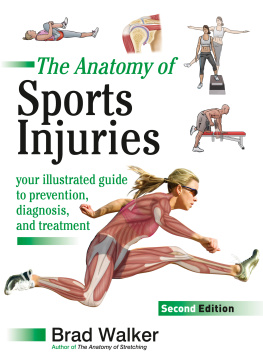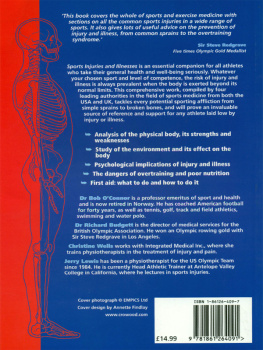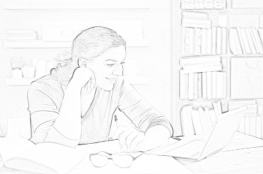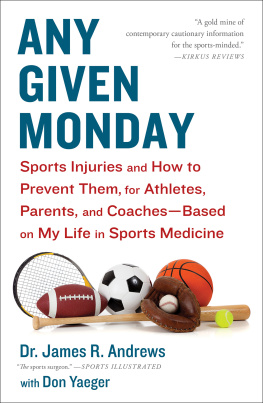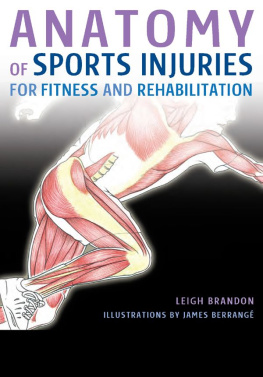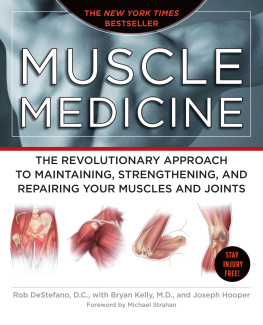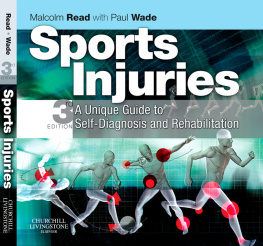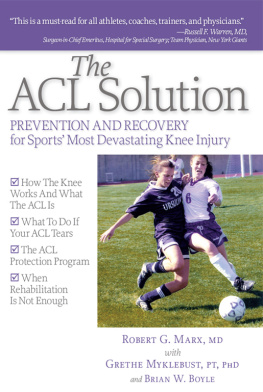
The Anatomy of Sports Injuries
Your Illustrated Guide to Prevention,
Diagnosis, and Treatment
Second Edition
Brad Walker

Copyright 2007, 2013, 2018 by Brad Walker. All rights reserved. No portion of this book, except for brief reviews, may be reproduced, stored in a retrieval system, or transmitted in any form or by any means electronic, mechanical, photocopying, recording, or otherwise without the written permission of the publisher. For information, contact Lotus Publishing or
North Atlantic Books.
First published in 2007. This second edition published in 2013 and redesigned in 2018 by
Lotus Publishing
Apple Tree Cottage, Inlands Road, Nutbourne, Chichester, PO18 8RJ and
North Atlantic Books
Berkeley, California
Anatomical Illustrations Amanda Williams
Exercise Illustrations Matt Lambert
Text Design Medlar Publishing Solutions Pvt Ltd., India
Cover Design Jim Wilkie
Printed and Bound in Malaysia by Tien Wah Press
The Anatomy of Sports Injuries: Your Illustrated Guide to Prevention, Diagnosis, and Treatment is sponsored and published by the Society for the Study of Native Arts and Sciences (dba North Atlantic Books), an educational nonprofit based in Berkeley, California, that collaborates with partners to develop cross-cultural perspectives, nurture holistic views of art, science, the humanities, and healing, and seed personal and global transformation by publishing work on the relationship of body, spirit, and nature.
North Atlantic Books publications are available through most bookstores. For further information, visit our website at www.northatlanticbooks.com or call 800-733-3000.
British Library Cataloguing-in-Publication Data
A CIP record for this book is available from the British Library
ISBN 978 1 905367 38 2 (Lotus Publishing)
ISBN 978 1 62317 283 1 (North Atlantic Books)
The Library of Congress Cataloguing-in-Publication has catalogued the first edition as follows:
Walker, Brad, 1971
The anatomy of sports injuries / Brad Walker.
p. ; cm.
Includes bibliographical references and index.
ISBN 978-1-55643-666-6 (North Atlantic Books : pbk.)
1. Sports injuries--Atlases. I. Title.
[DNLM: 1. Athletic Injuries--Atlases. 2. Athletic Injuries--Handbooks.
3. Athletic Injuries--therapy--Atlases. 4. Athletic
Injuries--therapy--Handbooks. QT 29 W177a 2007]
RD97.W35 2007
617.1027--dc22
2007010564
VD1
Contents
Acute
Acute
Chronic
Acute
Chronic
Acute
Chronic
Acute
Chronic
Acute
Chronic
Acute
Acute
Chronic
Acute
Chronic
Acute
Chronic
Acute
Chronic
Acute
Chronic
Acute
Chronic
Introduction
A s sports participation rates increase, so does the occurrence of sport-related injury. As a consequence, there is a need for detailed, easy-to-understand reference books on the prevention, treatment and management of sports injury.
Whilst there are many books dealing with this subject, very few present detailed anatomical information in a way that is easy to understand for everyone from the weekend warrior to the professional athlete; from the first-year personal trainer to the seasoned sports coach or from the recent university graduate to the accomplished sports doctor.
Combining real-life practical experience with detailed theory, Brad Walker presents complex prevention, treatment and management strategies in a way that everyone can understand. Full-color illustrations provide a visual aid to the workings of the human body during the sports injury management process. The expert yet easy-to-follow information will help the reader prevent sports injury, and in the event that an injury does occur help to treat it effectively, allowing a return to activity in as little time as possible.
The Anatomy of Sports Injuries looks at sport-related injury from every angle. a comprehensive treatment and rehabilitation process is outlined to ensure a quick and complete recovery.
provide a detailed overview of 120 sports injuries in an easy-to-locate format. Divided into key areas of the body, each sports injury is described by: the anatomy and physiology involved, possible causes, signs and symptoms, complications, immediate treatment, rehabilitation procedures and long-term prognosis.
Aimed at fitness enthusiasts and health-care professionals of all levels, The Anatomy of Sports Injuries also provides strength and flexibility exercises to aid with sports injury prevention, treatment and rehabilitation. These exercises are by no means exhaustive and merely provide guidance. Consult a healthcare professional for a tailor-made programme to suit your individual needs.
Anatomical Directions
Abduction | A movement away from the midline (of the body or foot/hand). |
Adduction | A movement toward the midline (of the body or foot/hand). |
Anatomical
position | The body is upright with the palms of the hands turned forward. |
Anterior | Toward the front of the body (as opposed to posterior). |
Circumduction | Movement in which the distal end of a bone moves in a circle while the proximal end remains stable. |
Contralateral | On the opposite side. |
Coronal plane | A vertical plane at right angles to the sagittal plane which divides the body in to anterior and posterior portions. |
Deep | Away from the surface (as opposed to superficial). |
Depression | Movement of a body part downward. |
Distal | Away from the point of origin of a structure (as opposed to proximal). |
Dorsal | Relating to the back or posterior portion (as opposed to ventral). |
Elevation | Movement of a part of the body upward in the coronal plane. |
Eversion | To turn the sole of the foot outward. |
Extension | A movement at a joint resulting in separation of two ventral surfaces (as opposed to flexion). |
Flexion | A movement at a joint resulting in approximation of two ventral surfaces (as opposed to extension). |
Horizontal
plane | A transverse plane at right angle to the long axis of the body. |
Inferior | Below or furthest away from the head. |
Inversion | To turn the sole of the foot inward. |
Lateral | Away from the midline of the body or organ (opposite to medial). |
Medial | Toward the midline of the body or organ (opposite to lateral). |
Median | Centrally located, situated in the middle of the body. |
Opposition | A movement specific to the saddle joint of the thumb that enables the thumb to touch the tips of the fingers of the same hand. |
Palmar | Anterior surface (palm) of the hand. |
Plantar | The sole of the foot. |
Posterior | |
Next page
